Начну с того, что маленькие и самобытные города я просто обожаю! Как правило, путешествие в Германию ассоциируется с посещением таких больших мегаполисов, как Берлин и Мюнхен, в крайнем случае, Дрезден. Ничего не имею против этого, Мюнхен мне самой понравился, к Дрездену у меня тоже есть симпатия, а по поводу Берлина, могла бы поспорить. Но, как говорится, на вкус и цвет…
Но вот в том, что две маленькие жемчужинки Германии – Трир и Веймар, придутся по душе каждому, просто уверена. Ну, не могут оставить равнодушными города, где чуть ли не на каждом квадратном метре памятники всемирного наследия.
Недалеко от границы с Люксембургом, в долине реки Мозель находится древнейший город Германии Трир. Основан он был еще в 6 веке до н. э. римлянами, поэтому Трир – самый старый город Германии. Основал город Октавиан Август и первоначально он назывался Августа Треверорум, и уже позже был переименован в Трир.
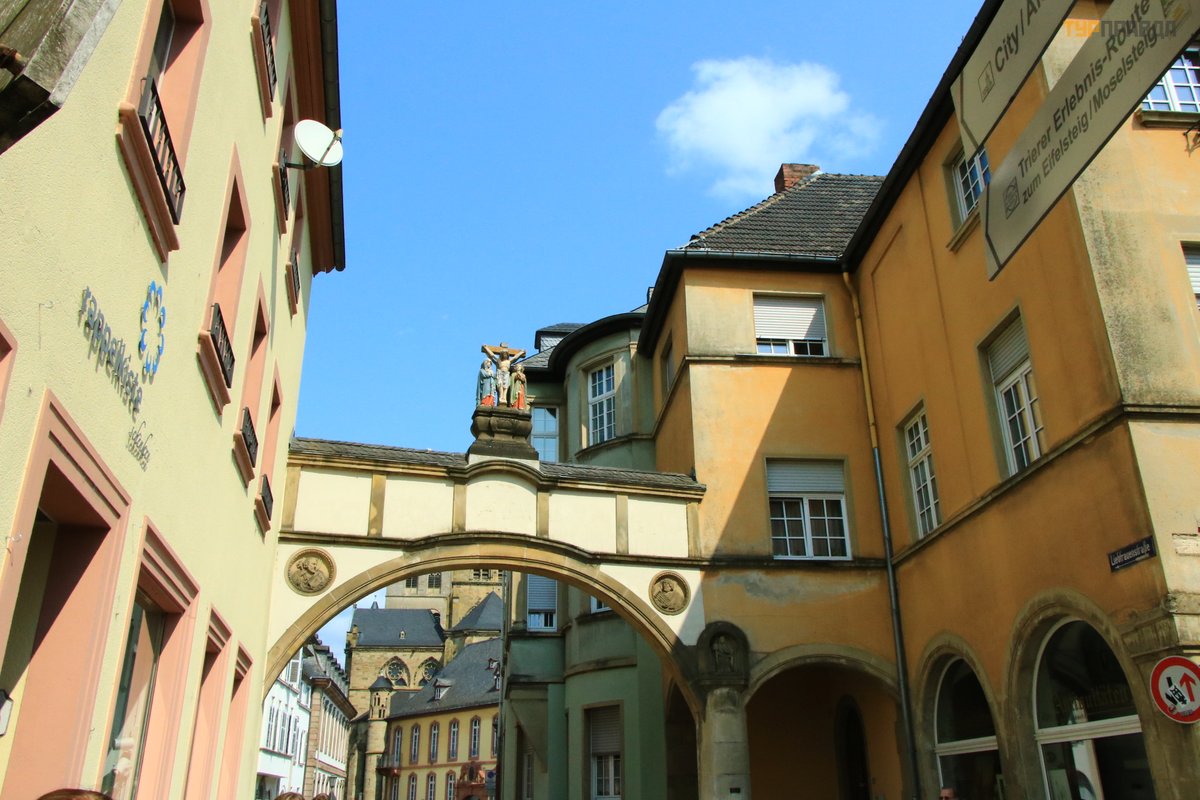
Визитной карточкой города являются северные ворота Порта Нигра (черные ворота), построенные во 2 веке н. э. , войдя в которые вы попадаете в город, и, выйдя из которых, покидаете его.
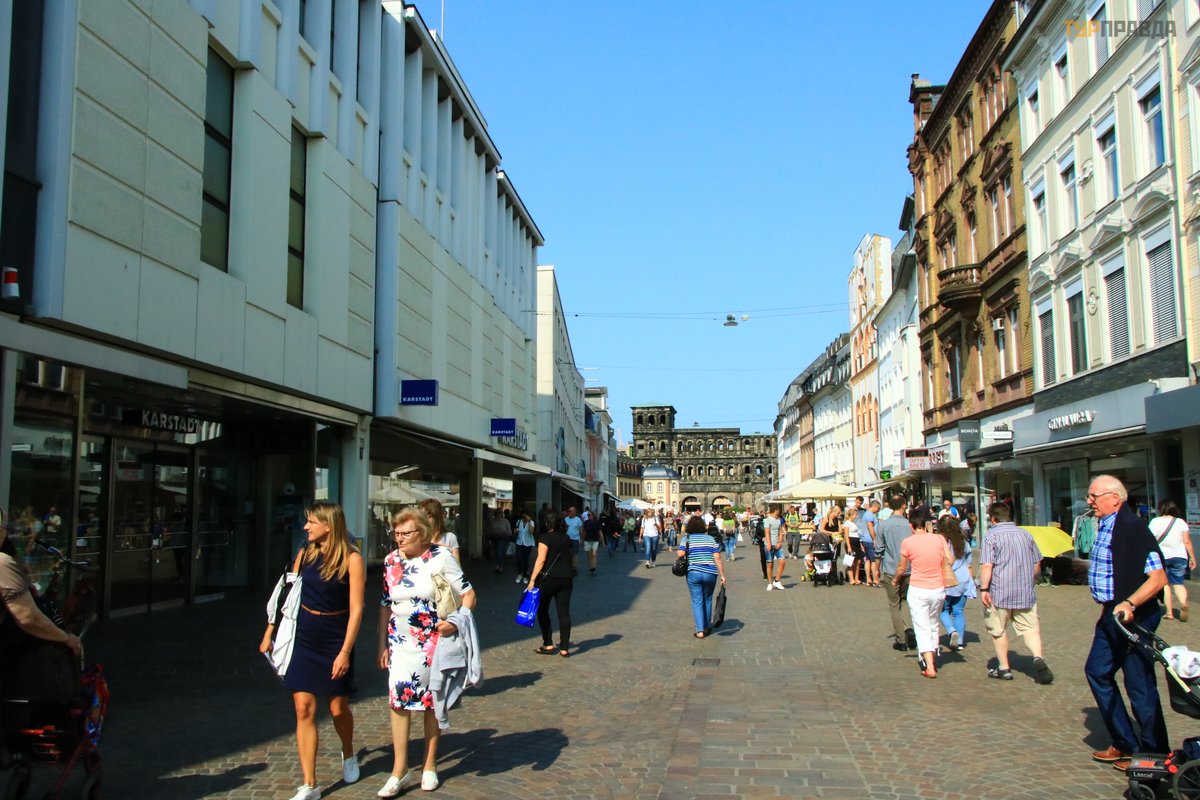
Очень удивляет тот факт, что ворота до сих пор стоят, не смотря на то, что воздвигались они без раствора и цемента, а скобы, которыми римляне скрепляли между собой камни, были раскрадены. А ворота вот они, стоят, встречают и провожают гостей.
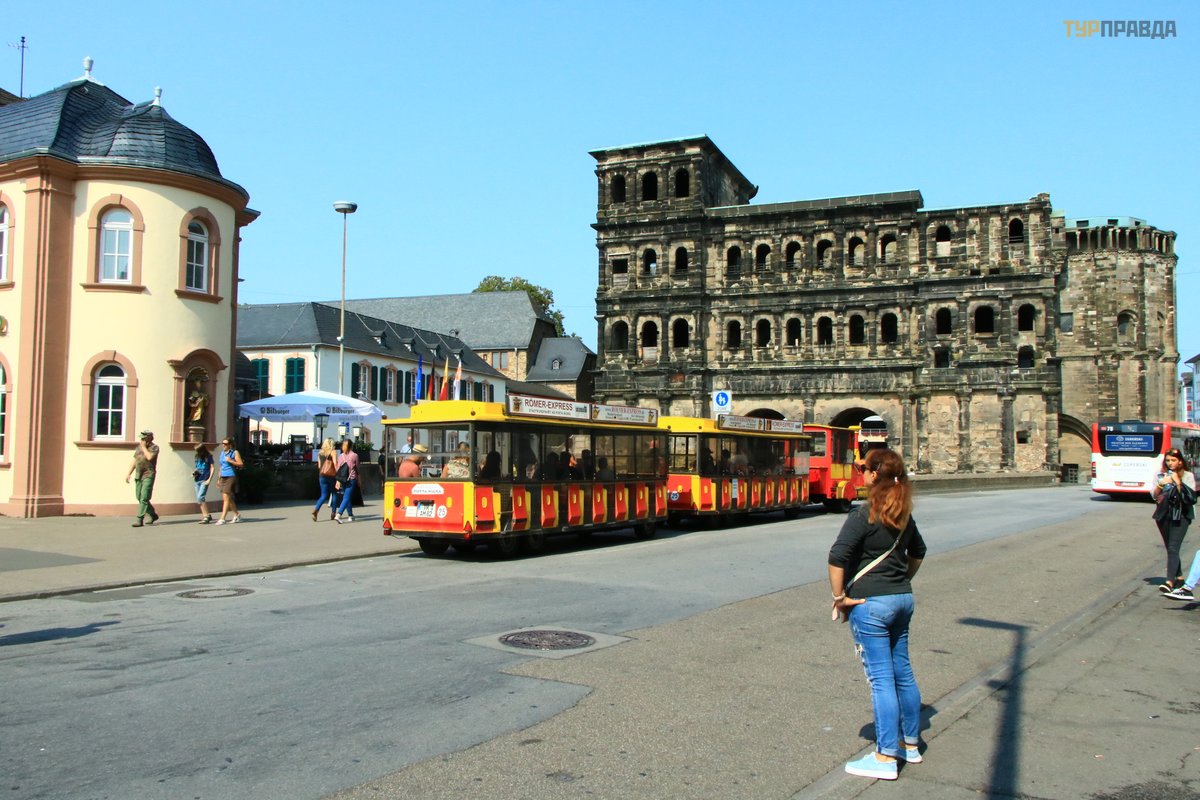
Еще одним уникальным памятником старины является Церковь Богоматери.
Она считается самой древней готической церковью Германии, и была построена на фундаменте древнеримской церкви в 1260 году.


К церкви прилегает Собор Святого Петра.
Это самый старейший храм Германии, строительство которого началось в 326 году по распоряжению первого христианского императора Константина. Но, к сожалению, в 882г. здание было разрушено вторгшимися норманнскими племенами, однако в 1196 г. было восстановлено в прежнем облике. В этом Соборе хранятся удивительные артефакты истории христианства. Одна из главных святынь христианского мира – хитон Иисуса Христа, полученный одним из охранников по жеребьевке перед распятием. Сейчас хитон покоится в хрустальном саркофаге и достается один раз в несколько лет на страстную пятницу. Также в Соборе находится ковчег с главой Святой Елены, звенья цепи, которой был скован Апостол Петр и гвоздь и сандалий Святого Андрея Первозванного. Вот какие реликвии хранит этот древний Собор!


Есть в Трире и резиденция архиепископов.
Это роскошный Дворец Курфюрстов, представляющий собой целый архитектурный ансамбль, построенный в стиле ренессанса и рококо, украшенный белыми псевдоантичными статуями и позолотой.


Окружает Дворец великолепный парк, с цветниками и фонтанами, который является излюбленным местом для прогулок и отдыха горожан и гостей.


Сердцем города считают главную рыночную площадь Хауптмаркт. Находится она в историческом районе на пересечении самых важных торговых улиц средневекового Трира.

В центре площади стоит Рыночный крест, установленный еще в 958 году по распоряжению Генриха I. Эта каменная колонна с крестом наверху является символом суверенитета и показывает власть церкви над городом.


Неподалеку находится еще один шедевр Трира – фонтан Святого Петра. Построен он был в 1595 году в стиле ренессанса. Сверху фонтан украшен скульптурой Апостола Петра, а у его основания расположены четыре женские фигуры, символизирующие силу, мудрость, правосудие и умеренность.

До наших дней сохранились не все застройки тех времен, но все же большая их часть была сохранена. И вот мы видим различные дома в стиле ренессанса, барокко и классицизма, некоторые из которых датируются 12 веком. Самые известные дома – это Дом Трех Королей в мавританском стиле и Красный Дом.

Красный дом считают одним из настоящих украшений Трира. Примечателен он тем, что именно на нем выгравирована золотом надпись « Трир стоял раньше Рима на тысячу триста лет, пусть он стоит и дальше, радуется вечному миру! Аминь! » Ну, конечно же, фраза о превосходстве Трира над Римом – это выдумка, но все же именно она, приковывает взгляды туристов.
От площади Хауптмаркт во все концы города отходят разные улочки, ведущие в средневековые кварталы.
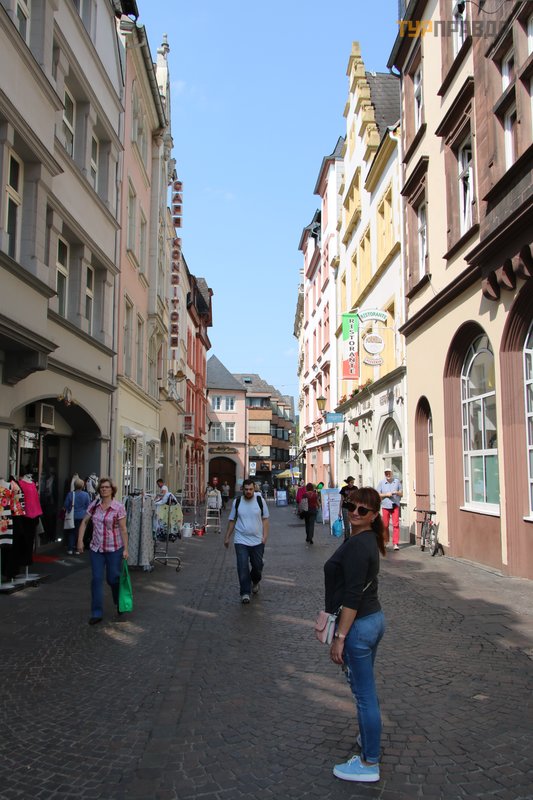
Примечателен город еще тем, что в нем родился лидер коммунистических идей Карл Маркс, и мой муж все порывался найти дом, где проживал этот гигант мысли, но я резонно ему отвечала, ну на кой он тебе сдался?
А какие красивые здесь отели. Очень хочется поселиться в этих разноцветных кукольных домиках надолго, по вечерам выходить на резной балкончик и любоваться сказочными пейзажам, наблюдая за жизнью города и горожан, а по утрам наслаждаться чашечкой ароматного кофе в предвкушении прогулки по самому древнему городу Германии.
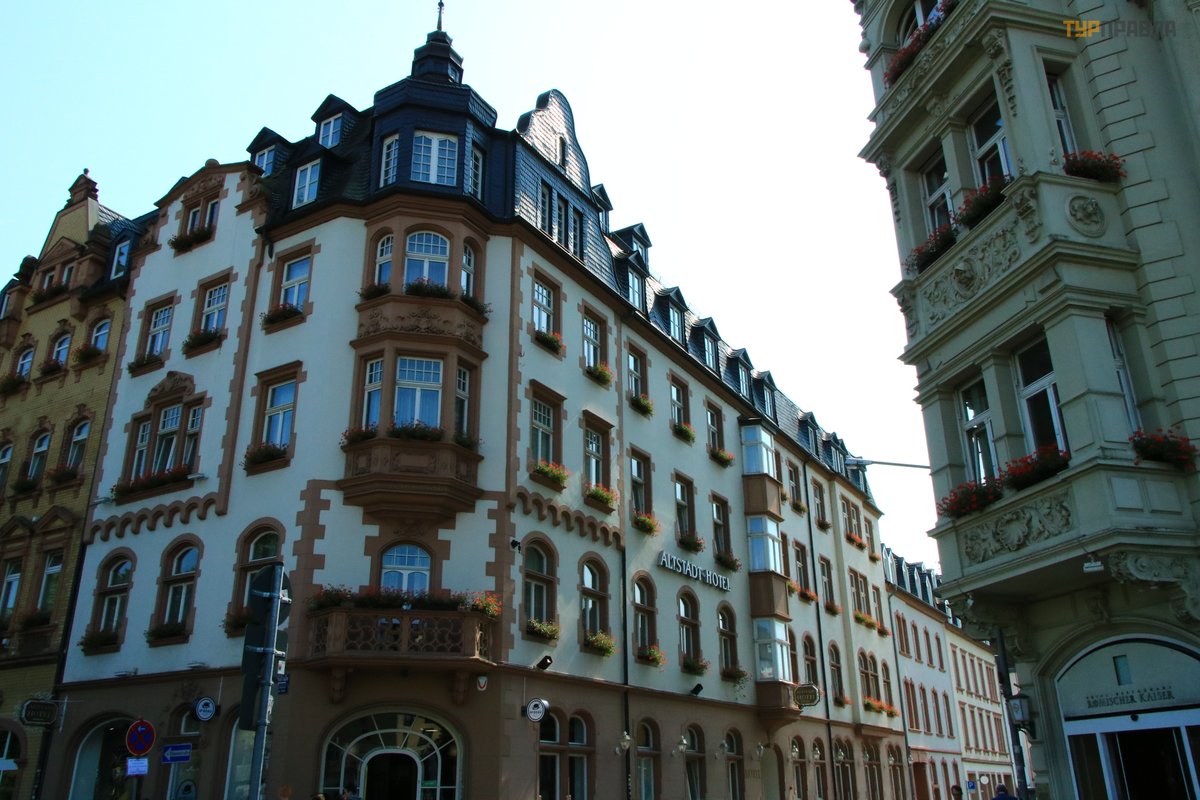

Гуляя по городу, наткнулись на народного умельца, который крутил из обычной проволоки различные забавные вещицы.

Поражает не только старина, кружевные узорные домики, дворцы, парки и средневековые соборы. Поражает идеальная чистота улиц, возникает ощущение, что их моют с шампунем. Обратите внимание на грузовик с идеально чистыми колесами, здесь совершенно нет пыли.

И во всем строгие правила и инструкции. Зайдя в туалет, обнаружила забавное пособие (наверное, для наших соотечественников).

Ну и какая прогулка без шоколадки? Пошла искать шоколадницу, нашла свой любимый Линдт, обрадовалась.

В качестве подарка из Трира лучше всего привезти яблочное мозельское вино.
В общем, в Трире мы посмотрели лишь десятую часть всех достопримечательностей, а как много хотелось бы увидеть. Но у нас запланирован еще один маленький, но от этого не менее интересный городок – центр культуры и литературы Германии Веймар, расположенный на земле с красивым названием Тюрингия.
Сразу скажу, что Веймар – это город не для развлечений, и уж точно не для шопинга. Это место тех, кто любит немецкую культуру, классическую литературу и музыку. Этот город подарил миру двух великих поэтов - Шиллера и Гете. Здесь они жили, творили, восхищая своими произведениями всех любителей поэзии, здесь же и похоронены, а перед зданием Немецкого национального театра им возведен памятник, где один великий поэт дружески положил руку на плечо другому.

А в эту дверь каждый день входил знаменитый отец Фауста великий Гете.

Рядом с домом Шиллера установлен забавный фонтан « Мужичок с гусями» .

И именно в Веймаре родился легендарный Карл Цейс.

Любил бывать в Веймаре и знаменитый сказочник Ганс Христиан Андерсен, о чем свидетельствует установленная в городе памятная плита.

Свою историю этот небольшой городок ведет еще с 10 века, и, не смотря на свои небольшие размеры, несколько раз был столицей округа. Уже в 18 веке он становится центром немецкого просвещения. Кроме Шиллера и Гете, известными жителями города были Фридрих Ницше и русская княжна Мария Павловна, а также величайшие композиторы Ференц Лист и Иоганн Себастьян Бах (здесь же он и похоронен).


И даже всеми любимый великий русский поэт Александр Сергеевич Пушкин возвышается здесь на постаменте, на улице Пушкинштрассе, которую немцы специально так переименовали в честь великого поэта.
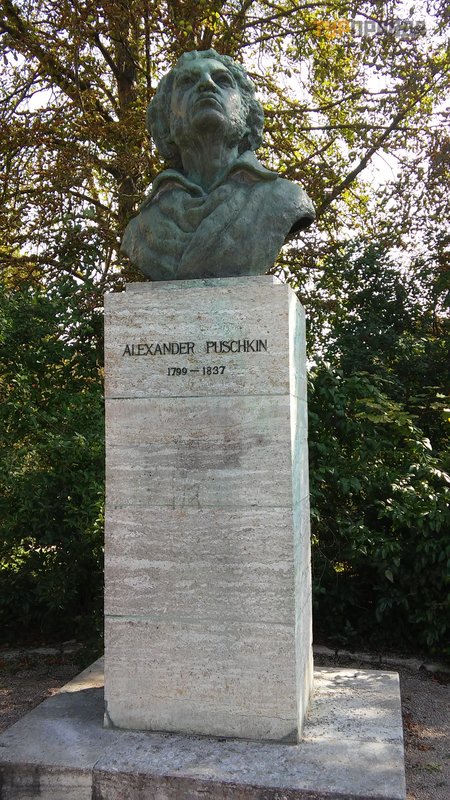
Нам уже привычно, что каждый европейский город строился вокруг площади. Не стал исключением и Веймар, главной площадью которого является Markt. Единственным отличием является то, что площадь имеет форму квадрата, а не прямоугольника, как обычно. Здесь же на площади находится туристический центр, в котором можно заказать экскурсию по городу и приобрести карту с достопримечательностями.

Центральным зданием на площади, традиционно является Ратуша.
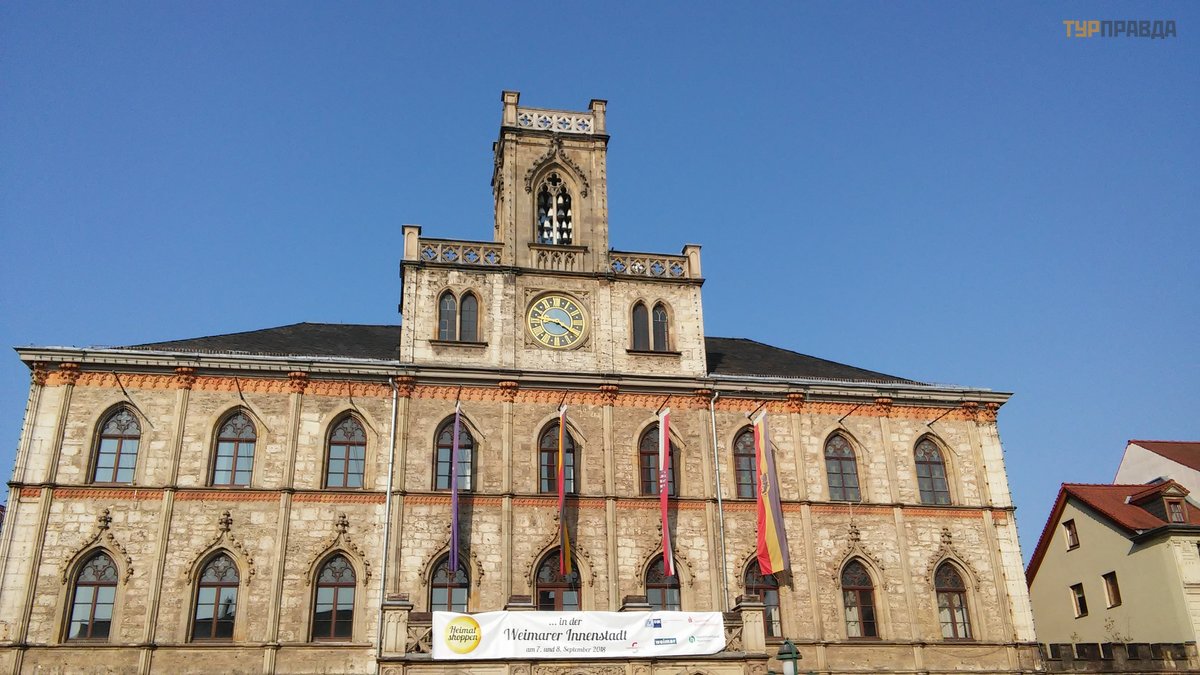
В Веймаре она не самая красивая, но ее непривлекательность компенсируют « пряничные домики в глазури» с интересными вензелями, которые окружают площадь.

Традиционно, как и на каждой площади, здесь есть свой фонтан, который так и называется « Рыночный фонтан» . Установлен он еще в 16 веке, а вот венчающая его фигура Нептуна появилась только в конце 19 века.


Примечательно, что в Веймаре вообще нет многоэтажных зданий. Обычный городской пейзаж – это одно, двух и трехэтажные домики, большая часть из которых построена в 18 – 19 веках, вымощенные брусчаткой улицы, и полное отсутствие тесноты. А еще здесь нет никакой промышленности, так как в 18 веке его правитель Карл Август запретил строить какие – либо заводы в городе. Может быть поэтому, горожане увековечили его в памятнике. Находится памятник прямо перед Княжеским Домом.

Что еще примечательно, в городе очень много маленьких кафе и даже есть меню на русском языке.
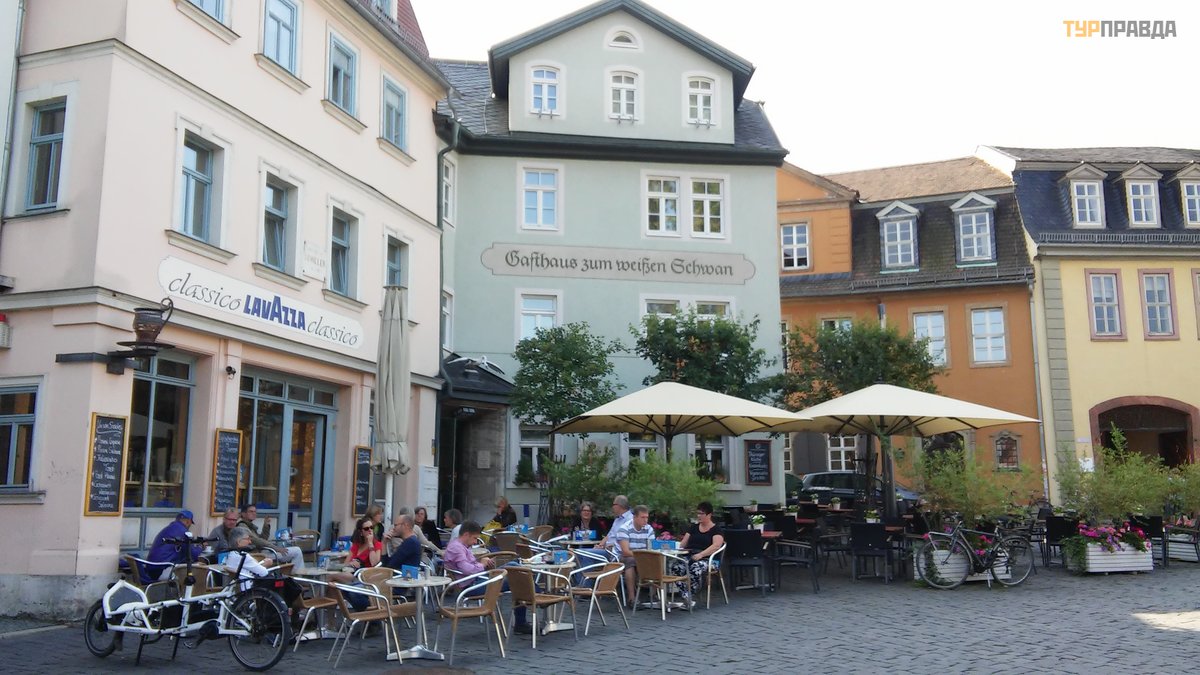
Одной из достопримечательностей Старого города является церковь Святого Петра и Павла. Построена она в 1500 году в готическом стиле, что традиционно для Германии. Церковь строгая и сдержанная, внутри тоже ничем не привлекает, разве что художественную ценность представляет собой алтарь, расписанный знаменитыми художниками эпохи Возрождения братьями Кранахами.


Местные называют эту церковь « Гердеркирхе» , так как в ней находится могила великого мыслителя Йоханна ГоттфридаГердера. Перед церковью горожане даже установили ему памятник.

Один из авторов алтаря Лукас Кранах старший проживал вот в этом доме, находящемся на центральной площади.
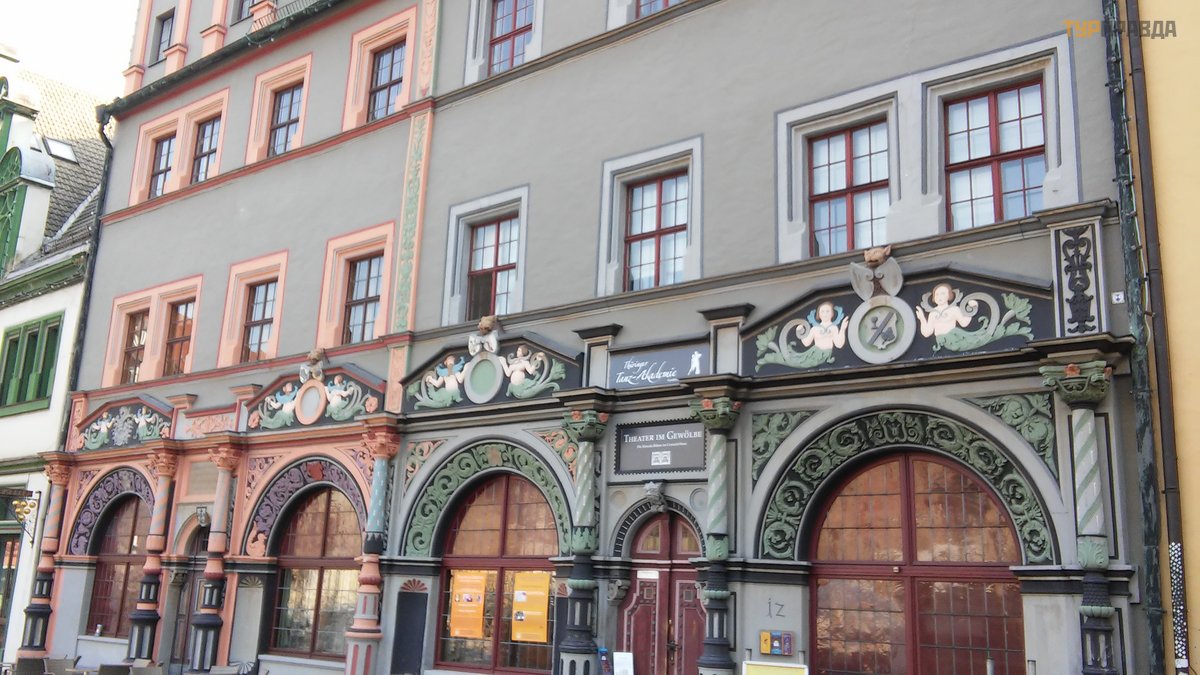
Дворцы в городе тоже не совсем дворцы, во всяком случае, по внешнему виду мало напоминают дворец в привычном его представлении.
К примеру, Дворец Виттумспалас (его еще называют Дворец Вдовы), получивший свое название после того, как в нем поселилась Герцогиня Анна Амалия, передав бразды правления своему сыну Карлу Августу. Сама же она всю себя посвятила развитию культуры Германии. Как внутри, так и снаружи, он больше похож на обыкновенный дом, так что дворец – это слишком громко сказано.

А это ак называемый Красный Замок, постройки середины 16 столетия. Фасад его украшают высокие фронтоны и нарядный портал. Рядом почему – то припаркована полицейская машина, охраняют его что ли?

Гуляя по городу, наткнулись на своеобразную авангардную скульптуру с глубоким философским смыслом.

Если нет времени гулять, а увидеть хочется многое, то можно проехаться на экскурсионном автобусе, который курсирует по городу.

А можно просто идти неспешным шагом, рассматривая достопримечательности.


Но есть у Веймара и страничка ужасающего прошлого. В его окрестностях находится один из самых страшных концлагерей – концлагерь Бухенвальд, в застенках которого находилось более 250 тысяч узников, 56 тысяч из которых были уничтожены. Поэтому в Веймаре построен Мемориал Памяти узникам Бухенвальда. Мы, к сожалению, не смогли посетить это место, чтобы почтить память погибших, но если Вы обладаете временем, конечно же, Мемориал нужно посетить.
Проживание в Вемаре: отель « Comfort Hotel Weimar” , по адресу: Ernst – Busse – Strabe. 4
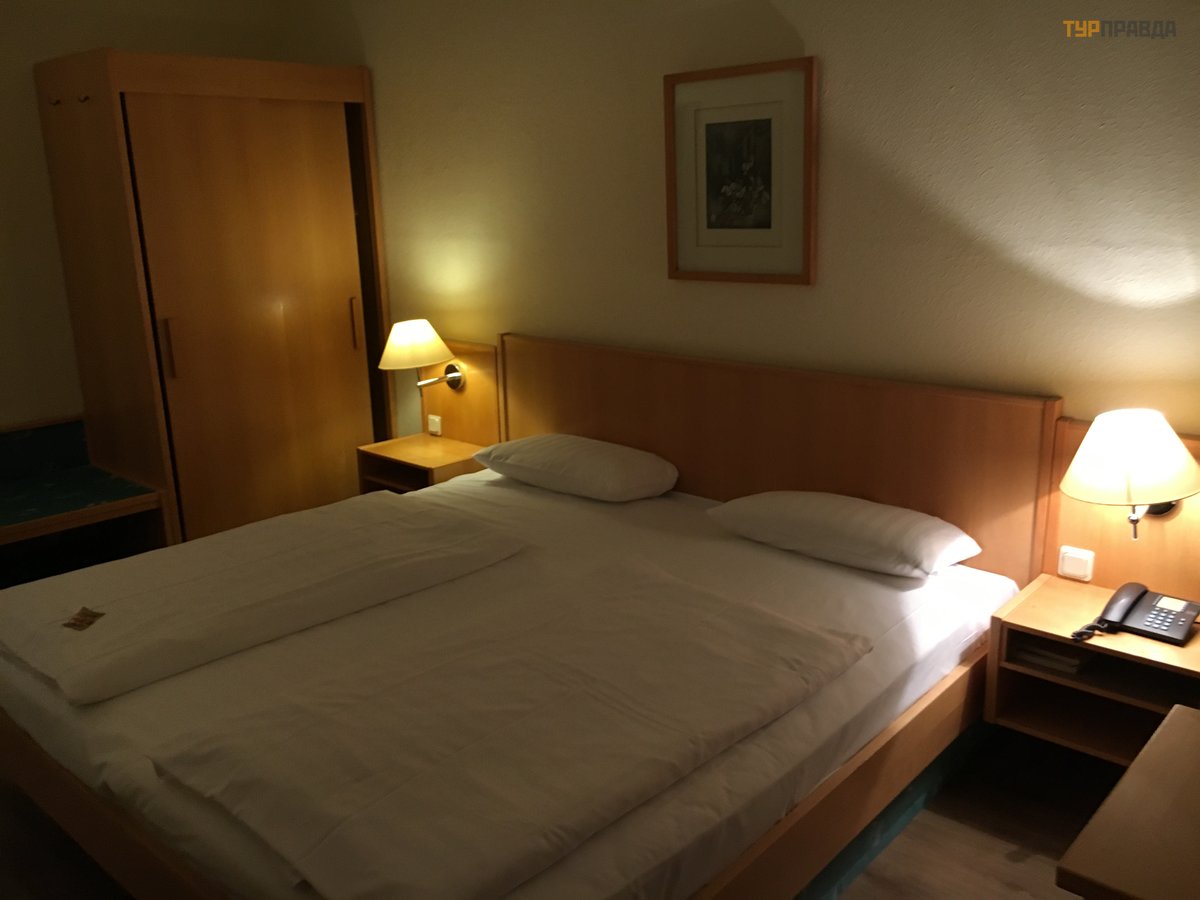


Отель в средней ценовой категории, условия проживания вполне сносные, завтрак даже можно сказать, отличный.
В заключение, хочу сказать, что мне очень понравилось гулять в этих маленьких исторических городках, без шума и суеты, имея возможность просто поразмышлять и даже пофилософствовать.
To begin with, I just adore small and original cities! As a rule, a trip to Germany is associated with visiting such large cities as Berlin and Munich, in extreme cases, Dresden. I have nothing against it, I liked Munich myself, I also have sympathy for Dresden, but I could argue about Berlin. But, as they say, the taste and color...
But the fact that two little pearls of Germany - Trier and Weimar, will appeal to everyone, I'm just sure. Well, they cannot leave indifferent cities, where almost every square meter has world heritage monuments.
Near the border with Luxembourg, in the valley of the Moselle River, the oldest city of Germany, Trier, is located. It was founded in the 6th century BC. Romans, therefore Trier is the oldest city in Germany. The city was founded by Octavian August and it was originally called Augusta Treverorum, and was later renamed Trier.

The hallmark of the city is the northern gate of the Porta Nigra (black gate), built in the 2nd century AD, entering which you enter the city, and exiting of which, leave it.

It is very surprising that the gates are still standing, despite the fact that they were erected without mortar and cement, and the staples with which the Romans fastened the stones together were stolen. And here they are, standing, meeting and seeing off guests.

Another unique monument of antiquity is Church of Our Lady.
Considered to be the oldest Gothic church in Germany, it was built on the foundations of an ancient Roman church in 1260.


The St. Peter's Basilica adjoins the church.
This is the oldest temple in Germany, the construction of which began in 326 by order of the first Christian emperor Constantine. But, unfortunately, in 882g. the building was destroyed by the invading Norman tribes, but in 1196 it was restored to its former appearance. This Cathedral houses amazing artifacts of the history of Christianity. One of the main shrines of the Christian world is the tunic of Jesus Christ, received by one of the guards by lot before the crucifixion. Now the tunic rests in a crystal sarcophagus and is taken out once every few years on Good Friday. Also in the Cathedral there is an ark with the head of St. Helena, links of the chain with which the Apostle Peter was shackled, and a nail and sandals of St. Andrew the First-Called. These are the relics that this ancient Cathedral keeps!


There is also a residence of archbishops in Trier.
This is a luxurious Palace of the Electors, which is a whole architectural ensemble built in the Renaissance and Rococo styles, decorated with white pseudo-antique statues and gilding.


The Palace is surrounded by a magnificent park with flower beds and fountains, which is a favorite place for walking and relaxing for citizens and guests.


The main Hauptmarkt market square is considered the heart of the city. It is located in the historic district at the intersection of the most important shopping streets of medieval Trier.

In the center of the square stands the Market Cross installed back in 958 by order of Henry I. This stone column with a cross on top is a symbol of sovereignty and shows the power of the church over the city.


Nearby is another masterpiece of Trier - St. Peter's Fountain. It was built in 1595 in the Renaissance style. On top of the fountain is decorated with a sculpture of the Apostle Peter, and at its base are four female figures, symbolizing strength, wisdom, justice and moderation.

Not all the buildings of those times have survived to this day, but most of them have been preserved. And here we see various Renaissance, Baroque and Classicist houses, some of which date back to the 12th century. The most famous houses are the Moorish-style House of the Three Kings and the Red House.

The Red House is considered one of the real decorations of Trier. It is notable for the fact that it is on it that the inscription “Trier stood before Rome for a thousand and three hundred years, let it stand further, rejoice in eternal peace! ” Amen! " Well, of course, the phrase about the superiority of Trier over Rome is a fiction, but still it is she who catches the eyes of tourists.
From the Hauptmarkt square, different streets lead to all parts of the city leading to the medieval quarters.

The city is also notable for the fact that the leader of communist ideas, Karl Marx, was born in it, and my husband kept trying to find a house where this giant of thought lived, but I reasonably answered him, well, why did he surrender to you?
And what beautiful hotels are here. I really want to live in these multi-colored doll houses for a long time, in the evenings go out to the carved balcony and admire the fabulous landscapes, watching the life of the city and the townspeople, and in the mornings enjoy a cup of aromatic coffee in anticipation of a walk around the most ancient city in Germany.


Walking around the city, we came across a craftsman who twisted various funny little things out of ordinary wire.

It is not only antiquity, lacy patterned houses, palaces, parks and medieval cathedrals. The perfect cleanliness of the streets is striking, there is a feeling that they are being washed with shampoo. Pay attention to the truck with perfectly clean wheels, there is absolutely no dust here.

And in everything there are strict rules and instructions. Going to the toilet, I found a funny manual (probably for our compatriots).

Well, what a walk without a chocolate bar? I went to look for a chocolate girl, found my beloved Lindt, was delighted.

It is best to bring Moselle apple wine as a gift from Trier.
In general, in Trier we saw only a tenth of all the sights, but how much we would like to see. But we have planned another small, but no less interesting town - Weimar, the center of culture and literature of Germany, located on the land with the beautiful name Thuringia.
I must say right away that Weimar is not a city for entertainment, and certainly not for shopping. This is the place for those who love German culture, classical literature and music. This city gave the world two great poets - Schiller and Goethe. Here they lived, created, delighting all lovers of poetry with their works, they are buried here, and a monument was erected to them in front of the building of the German National Theater, where one great poet laid a friendly hand on the shoulder of another.

And every day the famous father of Faust the great Goethe entered this door.

Next to Schiller's house there is a funny fountain "Peasant with Geese".

And it was in Weimar that the legendary Carl Zeiss was born.

The famous storyteller Hans Christian Andersen also loved to visit Weimar, as evidenced by a memorial plate installed in the city.

We are already accustomed to the fact that every European city was built around a square. Weimar is no exception, with Markt as its main square. The only difference is that the square is shaped like a square rather than a rectangle as usual. Here, on the square, there is a tourist center where you can book a city tour and purchase a map with attractions.

The central building on the square is traditionally the Town Hall.

In Weimar, it is not the most beautiful, but its unattractiveness is compensated by "glazed gingerbread houses" with interesting monograms that surround the square.

Traditionally, as in every square, there is a fountain here, which is called "Market Fountain". It was installed back in the 16th century, but the figure of Neptune crowning it appeared only at the end of the 19th century.


It is noteworthy that in Weimar there are no high-rise buildings at all. The usual urban landscape is one, two and three-story houses, most of which were built in the 18th - 19th centuries, streets paved with cobblestones, and a complete lack of crowding. And there is no industry here, since in the 18th century its ruler Karl Augustforbade building any factories in the city. Maybe that's why the townspeople immortalized him in a monument. There is a monument right in front of the Prince's House.

What is more remarkable, there are a lot of small cafes in the city and there is even a menu in Russian.

One of the attractions of the Old Town is the Church of St. Peter and Paul. It was built in 1500 in the Gothic style, which is traditional for Germany. The church is strict and restrained, inside it also does not attract anything, except that the altar, painted by the famous Renaissance artists, the Cranach brothers, is of artistic value.


Locals call this church “Herderkirche” because it contains the grave of the great thinker Johanne Gottfried Herder. In front of the church, the townspeople even erected a monument to him.

One of the authors of the altar Lucas Cranach the Elder lived in this house, located on the central square.

<
For example, Vittumspalas Palace (also called the Widow's Palace), which got its name after Duchess Anna Amalia settled in it, passing the reins of power to her son Karl August. She herself devoted herself entirely to the development of German culture. Both inside and out, it looks more like an ordinary house, so the palace is too strong a word.

And this is the so-called Red Castle, built in the middle of the 16th century. Its facade is decorated with high gables and an elegant portal. For some reason, a police car is parked nearby, guarding it or something ?

Walking around the city, we came across a kind of avant-garde sculpture with a deep philosophical meaning.

If there is no time to walk, but you want to see a lot, then you can take a tour bus that runs around the city.

Or you can just walk at a leisurely pace, looking at the sights.


But Weimar also has a page of a terrifying past. In its vicinity is one of the most terrible concentration camps - the Buchenwald concentration camp, in the dungeons of which there were more than 250 thousand prisoners, 56 thousand of whom were destroyed. Therefore, the Memorial to the Prisoners of Buchenwald was built in Weimar. Unfortunately, we were not able to visit this place to honor the memory of the dead, but if you have time, of course, the Memorial must be visited.
Accommodation in Wemar: Comfort Hotel Weimar", at Ernst-Busse-Strabe. 4



The hotel is in the middle price category, the living conditions are quite tolerable, the breakfast can even be said to be excellent.
In conclusion, I want to say that I really enjoyed walking in these small historical towns, without the hustle and bustle, having the opportunity to just think and even philosophize.











































































































Agree 100%!!!!!!!!!!
This is my favorite city! :)
Согласна на 100%!!!!!!!!!!
Это мой самый любимый город! :)
Agree 100%!!!!!!!!!!
This is my favorite city! :)
Согласна на 100%!!!!!!!!!!
Это мой самый любимый город! :)